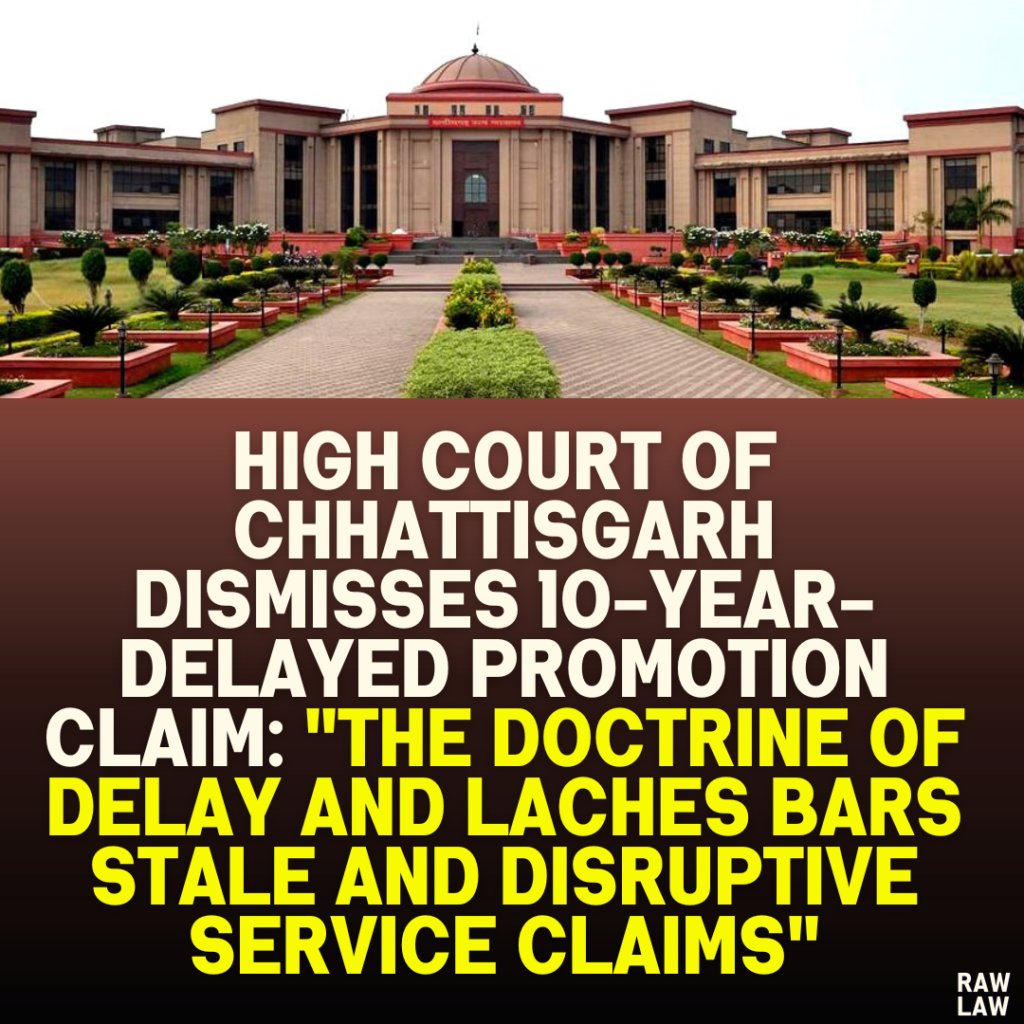Court’s Decision
The High Court of Chhattisgarh dismissed the petition seeking promotion to the post of Principal, citing a ten-year delay in filing the claim. The court emphasized that the petitioner had been neither vigilant nor proactive in asserting his rights. The court relied heavily on the doctrine of delay and laches, asserting that such delays jeopardize the rights of others and disrupt the settled positions in service-related matters.
Facts
- The petitioner was promoted as Headmaster (Untrained) in 2012, serving at a Government Higher Middle School in Dantewada, Chhattisgarh.
- A 1979 circular issued by the State Government provided eligibility for promotion to the post of Principal based on the following conditions:
- Completion of 20 years of service, or
- Attainment of 50 years of age.
- The petitioner joined service in 1987, completed 20 years of service in 2007, and attained 50 years of age in 2014, satisfying both criteria for promotion.
- Despite fulfilling eligibility, the petitioner alleged that his promotion was overlooked.
- The petitioner filed the present writ petition in 2024, claiming his entitlement to the promotion.
Issues
- Primary Legal Question: Whether the petitioner’s delay in filing the writ petition, despite being eligible for promotion since 2007 or 2014, precludes relief under the doctrine of delay and laches.
Petitioner’s Arguments
- The petitioner contended that he met the criteria for promotion under the 1979 circular upon attaining 20 years of service and 50 years of age.
- He argued that the authorities had neglected his rightful claim to promotion.
- The petitioner sought a court direction to the respondent authorities to consider and grant his promotion to the post of Principal.
Respondent’s Arguments
- The State Government countered the claim, highlighting that:
- The petitioner had delayed raising the issue since 2018 and filed the petition only in 2024, resulting in a substantial delay of ten years.
- Such delay and laches undermine the petitioner’s entitlement to any relief.
- The State urged the court to dismiss the petition, citing well-established legal precedents on the doctrine of delay and laches.
Analysis of the Law
The court analyzed the matter through the lens of delay and laches, relying on key precedents:
- P.S. Sadasivaswamy v. State of Tamil Nadu (1975):
- The Supreme Court ruled that a person aggrieved by a promotion must approach the court within six months to a year of the alleged grievance.
- It was held that courts should exercise discretion to refuse extraordinary relief to those approaching the court after prolonged delays.
- The court described delay in such matters as akin to “unscrambling a scrambled egg.”
- Bichitrananda Behera v. State of Orissa (2023):
- Reiterated that delay and laches are critical considerations, especially in service matters where third-party rights may be affected.
- Union of India v. Tarsem Singh (2008):
- Clarified exceptions to delay in cases of continuing wrongs, such as recurring pay disputes.
- However, in cases involving promotion and seniority, delays are rarely excused as they impact the rights of others.
- Union of India v. N. Murugesan (2022):
- Highlighted the distinction between delay and acquiescence. While delay indicates passivity, acquiescence implies an acceptance of the status quo.
The court emphasized that the petitioner’s conduct showed both delay and acquiescence, making his claim stale.
Precedent Analysis
The principles laid down in these judgments guided the court’s reasoning:
- The petitioner’s ten-year delay demonstrated negligence and passivity.
- Promotion disputes, particularly involving seniority, necessitate timely action to avoid disrupting settled rights.
- The petitioner failed to justify his inaction, thereby undermining his claim.
Court’s Reasoning
- The court scrutinized whether the petitioner’s delay could be excused:
- The petitioner attained eligibility for promotion as early as 2007 but failed to act.
- Despite multiple opportunities to assert his claim, the petitioner chose to remain silent.
- The court observed that delays create uncertainty, potentially jeopardizing the rights of others who may have benefited from promotions in the interim.
- Relying on precedents, the court concluded that the petitioner’s delay showed a lack of diligence and was sufficient grounds for dismissal.
The court noted:
“A court is not expected to give indulgence to such indolent persons… such delay does not deserve any indulgence.”
Conclusion
The court dismissed the writ petition, holding that:
- The petitioner’s ten-year delay in approaching the court was unjustifiable.
- Allowing the claim would disturb the settled rights of others and violate the principle of finality in service-related disputes.
Implications
This judgment reinforces the significance of timeliness in service matters. Key takeaways include:
- Promotion and seniority claims must be pursued promptly.
- Courts are unlikely to entertain stale claims, especially when they affect third-party rights.
- Employees must remain vigilant and act promptly to avoid losing their rights due to delay or acquiescence.
This decision serves as a reminder of the courts’ reliance on doctrines like delay and laches to maintain judicial efficiency and equity.




Pingback: Supreme Court Quashes Termination of Absentee Doctors, Directs Voluntary Retirement with Retrospective Effect from 2010: “Delay in Processing VRS Applications Cannot Justify Arbitrary Use of Article 311(2)(b)” - Raw Law
Pingback: Delhi High Court: Bank Cannot Unilaterally Alter Interest Rates in Violation of Sanction Letter and RBI Guidelines; Orders Refund of ₹2.04 Crores with 9% Interest, Upholding Borrower's Rights in Consortium Agreements - Raw Law